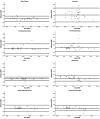Investigating the accuracy of Garmin PPG sensors on differing skin types based on the Fitzpatrick scale: cross-sectional comparison study
- PMID: 40212900
- PMCID: PMC11983641
- DOI: 10.3389/fdgth.2025.1553565
Investigating the accuracy of Garmin PPG sensors on differing skin types based on the Fitzpatrick scale: cross-sectional comparison study
Abstract
Background: Commercial wearable devices, which are often capable of estimating heart rate via photoplethysmography (PPG), are increasingly used in health promotion. In recent years, researchers have investigated whether the accuracy of PPG-measured heart rate varies based on skin pigmentation, focusing particularly on the accuracy of such devices among users with darker skin tones. As such, manufacturers of wearable devices have implemented strategies to improve accuracy. Given the ever-changing nature of the wearable device industry and the important health implications of providing accurate heart rate estimates for all individuals no matter their skin color, studies exploring the impact of pigmentation on PPG accuracy must be regularly replicated.
Objective: We aimed to contrast heart rate readings collected via PPG using the Garmin Forerunner 45 in comparison with an electrocardiogram (ECG) during various levels of physical activity across a diverse group of participants representing a range of skin tones.
Methods: Heart rate data were collected from adult participants (18-64 years of age) at a single study session using the Garmin Forerunner 45 PPG-equipped smartwatch and the Polar H10 ECG chest strap. Skin tone was self-reported via the Fitzpatrick scale. Each participant completed two 10 min bouts of moderate-intensity walking or jogging separated by a 10 min bout of light walking.
Results: A series of mixed ANOVAs indicated no significant interaction between Fitzpatrick score and phase of the activity bout (i.e., rest at the start, first intensity ramp-up phase, first steady-state phase, active rest, second ramp-up phase, and second steady-state phase). Similarly, there was no significant main effect for the Fitzpatrick score, although there was a significant main effect for phase, which was driven by greater ECG-recorded heart rate relative to PPG during the first ramp-up phase.
Conclusion: Our findings support prior research demonstrating no significant impact of skin tone on PPG-measured heart rate, with significant differences between PPG- and ECG-measured heart rate emerging during dynamic changes in activity intensity. As commercial heart rate monitoring technology and software continue to evolve, it will be vital to replicate studies investigating the impact of skin tone due to the rapidity with which widely used wearable technologies advance.
Keywords: equity; exercise; heart rate; physical activity; wearables.
© 2025 Icenhower, Murphy, Brooks, Irby, N’dah, Robison and Fanning.
Conflict of interest statement
The authors declare that the research was conducted in the absence of any commercial or financial relationships that could be construed as a potential conflict of interest.
Figures


Similar articles
-
Accuracy of Optical Heart Rate Sensing Technology in Wearable Fitness Trackers for Young and Older Adults: Validation and Comparison Study.JMIR Mhealth Uhealth. 2020 Apr 28;8(4):e14707. doi: 10.2196/14707. JMIR Mhealth Uhealth. 2020. PMID: 32343255 Free PMC article.
-
Accuracy of heart rate measured by military-grade wearable ECG monitor compared with reference and commercial monitors.BMJ Mil Health. 2025 Mar 21;171(2):144-149. doi: 10.1136/military-2023-002541. BMJ Mil Health. 2025. PMID: 38053265
-
Validity of heart rate measurements in wrist-based monitors across skin tones during exercise.PLoS One. 2025 Feb 10;20(2):e0318724. doi: 10.1371/journal.pone.0318724. eCollection 2025. PLoS One. 2025. PMID: 39928630 Free PMC article.
-
Accuracy of Heart Rate Measurement with Wrist-Worn Wearable Devices in Various Skin Tones: a Systematic Review.J Racial Ethn Health Disparities. 2023 Dec;10(6):2676-2684. doi: 10.1007/s40615-022-01446-9. Epub 2022 Nov 14. J Racial Ethn Health Disparities. 2023. PMID: 36376641 Free PMC article.
-
Impact of Skin Pigmentation on Pulse Oximetry Blood Oxygenation and Wearable Pulse Rate Accuracy: Systematic Review and Meta-Analysis.J Med Internet Res. 2024 Oct 10;26:e62769. doi: 10.2196/62769. J Med Internet Res. 2024. PMID: 39388258 Free PMC article.
References
-
- World Health Organization. Physical activity. (2024). Available at: https://www.who.int/news-room/fact-sheets/detail/physical-activity (accessed February 16, 2025)
-
- Hirten RP, Danieletto M, Tomalin L, Choi KH, Zweig M, Golden E, et al. Factors associated with longitudinal psychological and physiological stress in health care workers during the COVID-19 pandemic: observational study using apple watch data. J Med Internet Res. (2021) 23(9):e31295. 10.2196/31295 - DOI - PMC - PubMed
LinkOut - more resources
Full Text Sources
Research Materials

